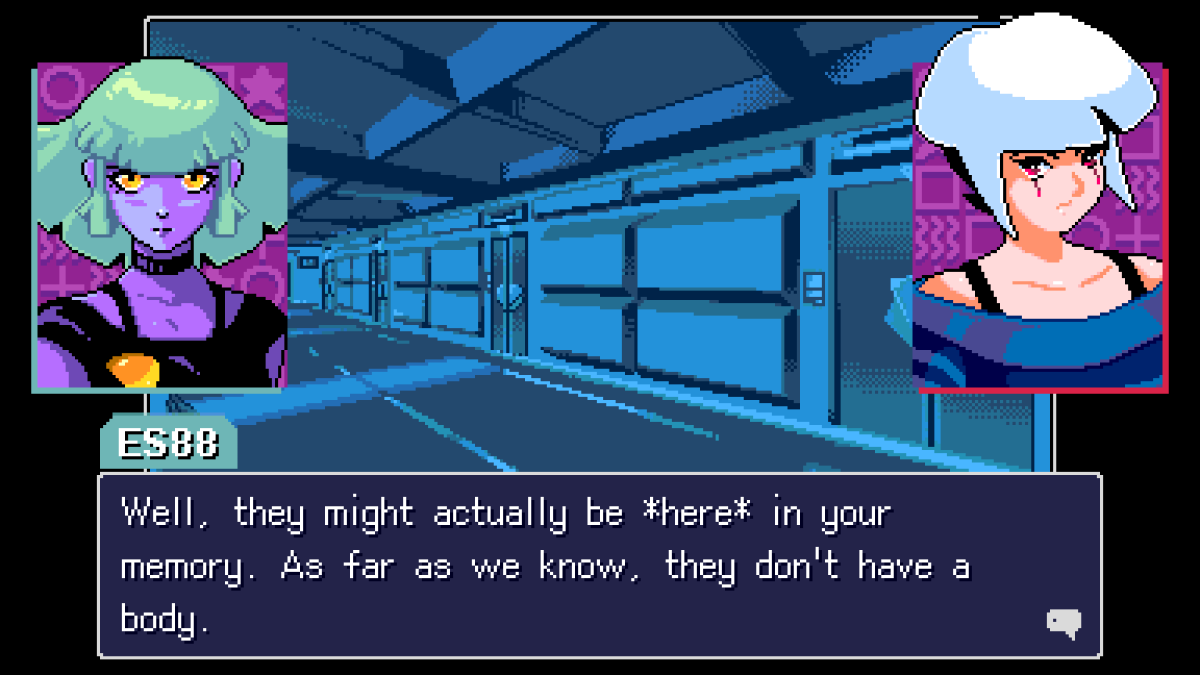There’s been an uptick to the brightside lately, and that’s excluding the deluge of wholesome games that have become part and parcel of the indie scene as of late. Pessimism is no longer at the forefront, or at the very least, without a contextual reason to be uprooted - even our cyberpunk scene has to be hopeful. At the very least, Read Only Memories: NEURODIVER is an apt example of that.
This is the latest release from California-based developers MidBoss, and a sequel to their modest cyberpunk adventure game 2064: Read Only Memories. Published by Chorus Worldwide Games, Read Only Memories: NEURODIVER fits rather snugly alongside their cozy adventure titles and point-n-click hybrids like Coffee Talk and A Space for The Unbound.
Taking place 6 years after the original’s story involving the breakthrough of sapient machines, NEURODIVER focuses on a new character, ES88, a psychic detective working at MINERVA, a secretive organization specializing in neurotechnology. Together with the genetically engineered and titular “Neurodiver” and potential android flame GATE, you’re tasked with tracking down “Golden Butterfly”, a rogue telepath who has hidden themselves away in various memories of the population of Neo-San Francisco.
In turn, you dive into those memories yourself to unscramble them and figure out Golden Butterfly’s ulterior motive.

From a visual design standpoint, NEURODIVER does well to be pragmatic, not just by paying lip service to similar games like Snatcher, but to the real world as well. It’s a nostalgic burst of escapism contending with what a world would look like with just these technical advancements. It’s too much for flying cars, but under the right conditions, you can have body modifications, and a trans-atlantic train journey to reach California.
Narratively, however, NEURODIVER seems to insist that you have at least a modicum of knowledge in regard to its predecessor. The memory ironically wanes when it comes to my personal recollection of 2064: Read Only Memories, not because of its accessible and, quite frankly, endearing world, but because the voice acting was an order too tall to elicit endearment. Thankfully, it’s an option you can turn off, both in 2064 and NEURODIVER.
It’s a side story, or at least, feels like one. 2064 is a deluge of conspiracies, all surface-level, but feeding into one another to build upward thanks to characterization, punchy moments, and emotional resonance. NEURODIVER, by comparison, is an antithesis of established ethos - not a betrayal of set-up, but an undermining of character, creation, connections, and simple study that either doesn’t trust the player to understand or assumes that they’re not there for thought.

As a game, NEURODIVER takes a hatchet to the point-n-click elements that established 2064 in favor of a solitary puzzle element. When ES88 dives into people's memories, it plays out like normal, with ES88 and the recipient in person providing commentary and thoughts about why it’s the memory chosen to be scrambled. Once the corrupted memory shows up, you pick up a small smattering of items found in the memory and jam them together until the memory unscrambles.
It’s a mechanic that quickly loses its luster once you realize just how little NEURODIVER cares about it to begin with. Indeed, once you begin to piece together the major players in the story, the game quickly deflates any expectation, as you don’t get a Neo-San Fran mystery to defy the ages, but a character study of impressively minimal proportions.
The result is a story that forces a static conclusion, one which fails to intensify its necessity and relies on remembrance, funnily enough. Maybe this is the issue when 2064 offers up espionage, conspiratorial claims, and technological achievements that’d see Harlan Ellison throw a fit, and the best NEURODIVER can offer is a lack of workplace security. Even with returning characters like Lexi Rivers, TOMCAT, and Turing, the cast is paltry and fails to make a dent in establishing any new faces.

This clearly hurts the new protagonist the most, ES88’s painfully flighty demeanor and unintended arrogance constantly undermining the danger she finds herself in. Instead, NEURODIVER moves at the pace of a hypercar, 3 years going by in the blink of an eye, and ES88 manages to portray that she’s learned next to nothing in her time at MINERVA.
Still, this would all be fine if the writing wasn’t so childish. Characters supposedly learn lessons, providing answers yet it’s never taken to the test, always a cause, but never an effect, nothing connects when it feels like it should. One of the few major story choices that can define how characters view you from that point on has such an absurdly evil position to take, yet its opposite is one of such obvious intent, that ES88 has to crowbar in a moral dilemma.
What is MINERVA? What’s the point of their operations? We’ve seen a world with ravaging wars, androids working overtime so their newfound personalities and titanium alloy skin don’t go to waste, and the best NEURODIVER can offer is tantamount to the Mystery Machine. We’re just short of a talking dog, and a man behind the mask.
The only difference is that there is no mystery here, not at least one that coalesces into a conclusion. NEURODIVER does well to set up, but never pays off exactly what this means for ES88, for MINERVA, for Neo-San Francisco, for the world. This is a fan-fiction, an advert for posters, and a reminder that nostalgia conquers all, and should define each aspect of your position.

Read Only Memories: NEURODIVER Review
It’s easy to fall for Read Only Memories: NEURODIVER. When its predecessor offers pronouns and preferences to directly suit you, it’s clear to see that MidBoss wants the world to cultivate you as much as you do it. Here, however, we have a character study of a supposedly sympathetic mule, one whose only parallels to humanity revolve around their taste in media.
Well, unless you work in the military-industrial complex, that is.
Read Only Memories: NEURODIVER was reviewed on Xbox Series S, using a copy provided by the developer over the course of 8 hours of gameplay - all screenshots were taken during the process of review.
Review Summary
Pros
- Fantastic visual design throughout each scene
- Initially compelling gameplay mechanics
Cons
- Gameplay mechanics are quickly forgotten in terms of complexity
- Writing fails to elevate its surface-level commentaries
- Moral positions to take are heavily imbalanced
- Narrative fails to escape a dead end in terms of stakes
Have a tip, or want to point out something we missed? Leave a Comment or e-mail us at tips@techraptor.net












